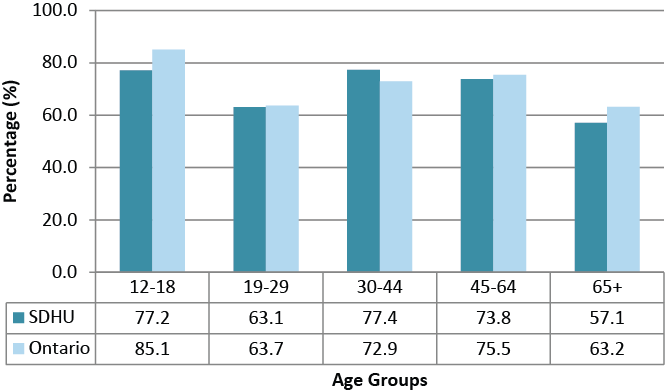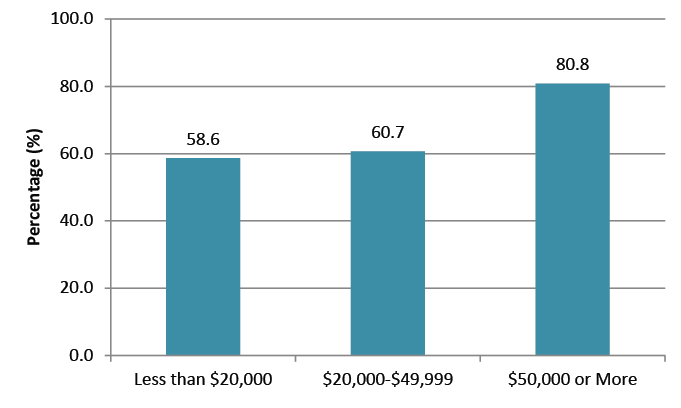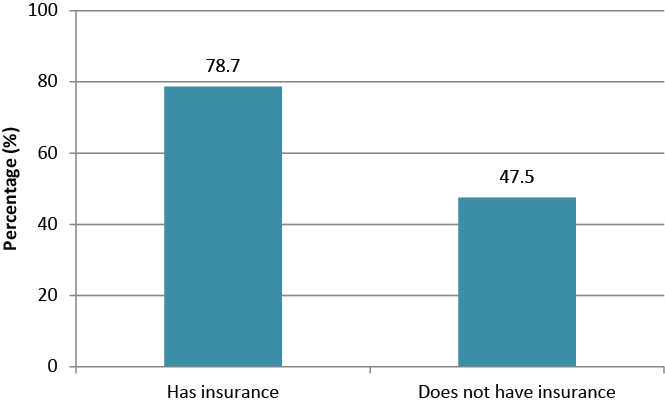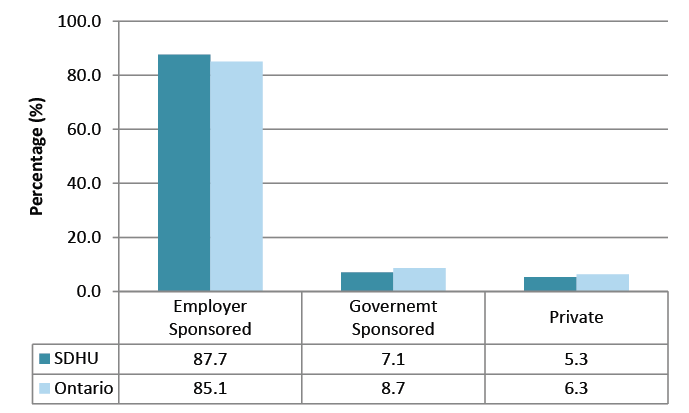Oral health statistics
- Dental Health Fact Sheet (PDF, 472 KB)
Oral health is important for personal appearance and a sense of well-being.
Poor oral health can be linked with serious health issues.
Dental caries (tooth decay) presents a common problem that begins in early childhood and worsens with age. Untreated dental decay can cause pain, a lack of sleep, and poor eating habits, which can lead to poor nutrition and decreased quality of life due to pain, chewing and speech problems, and low self-esteem.1
Fast facts
- In the 2007–2008 school year, 66% of Health Unit service areaa children screened at 5 years of age and 48% of children screened at 9 years of age were caries-free.b
- In 2009–2010, almost three-quarters (74%) of Health Unit area respondents to the Canadian Community Health Survey reported having oral health insurance. This is significantlyc higher than Ontario (66%).
- Physical, social, and economic conditions influence people’s opportunities to be healthy. Oral health is influenced by personal and financial stressors, access to insurance, and providers of oral health care.
Oral Health Program Update
The overall goal of Public Health Sudbury & Districts’ oral health program is to enable all children and youth to attain and sustain optimal oral health. Programs and services are delivered in accordance with the Ontario Public Health Standards and aligned with our agency’s strategic plan. Programming is evidence-informed and considers local needs. We provide both universal programming for all children and youth, and targeted initiatives for those at higher risk of poor oral health outcomes. This report (1MB-pdf) provides a brief update on our work related to five key priority areas:
- School screening and surveillance
- Healthy Smiles Ontario (HSO)
- Early Childhood Caries (ECC) Prevention
- Indigenous oral health
- Adult oral health inequities
Children’s oral health
During the 2007–2008 school year, 66% of children in the Health Unit’s area screened at 5 years of age were caries-free (no tooth decay). These results were similar to 2005–2006 (67%).
During the same school year, 48% of the children screened at 9 years of age were caries-free. This is a slight decrease from the 2005–2006 school year where 54% were caries-free.
In 2007–2008 an overall deft/DMFT Indexd score of 1.39 was observed for children 5 years of age and a deft/DMFT Index score of 2.22 was observed for children 9 years of age. No change was observed for the 5-year-olds from the 2005–2006 school year; however, there was an increase for 9-year-olds from 2005–2006 (1.91). Due to a change in the methodology, results are not comparable to the 2004–2005 school year and prior.
Oral health
In the Health Unit’s area, 30% of respondents to the Canadian Community Health Survey reported that their teeth were sensitive to hot and/or cold, 17% reported bad breath, 13% reported dry mouth, 12% reported bleeding gums and 9% reported having a tooth ache in the last month. Approximately 1 out of 5 respondents wore dentures (21%). Eight percent (8%) of respondents reported having teeth removed by a dentist in the last 12 months. Of those 8%, more than half (57%) had their teeth removed due to tooth decay or gum disease.
a SDHU area includes the census divisions (CDs) of Greater Sudbury, Sudbury District, and Manitoulin District.2
b Caries-free is defined as having all teeth coded in the WHO Modified Index used in the Dental Indices Survey as either 00 (sound) or 01 (sound with a sealant).3
c The values are statistically different and the difference is unlikely to have occurred by chance.
d The deft/DMFT Index measures the number of primary/permanent teeth decayed, missing/extracted, or filled because of decay relative to the total number of teeth examined among children aged 5 and 9 years.3
Dental visits
In 2009–2010, 70% of Sudbury residents reported seeing a dentist in the past year. Similar results were observed in Ontario (72%).
Overall in 2009–2010, a similar proportion of females in the Health Unit’s area reported visiting a dentist in the past year (72%) compared to area males (68%). Differences were observed across age groups. The 65-year-and-over age group had a significantly lower proportion of respondents who had visited the dentist in the past year (57%) than other age groups (age 30–44 and 45–64) (see Figure 1).
Figure 1. Dental visits within the past year, by age groups, Sudbury & District Health Unit and Ontario, 2009–2010

Source: Canadian Community Health Survey, 2009–2010
Table 1. Dental visits within the past year, by age groups, Sudbury & District Health Unit and Ontario, 2009–2010
Age group SDHU (%) Ontario (%)
12 to 18 years 77.2 85.1
19 to 29 years 63.1 63.7
30 to 44 years 77.4 72.9
45 to 64 years 73.8 75.5
65 and over 57.1 63.2
Significant differences were observed in the Health Unit’s area population related to the proportion of respondents visiting a dentist in the past year by household income group. Only 6 out of 10 individuals with household income less than $50,000 had visited a dentist in the previous year compared to 8 out of 10 individuals with household income of $50,000 or more (see Figure 2). This difference was significant.
Figure 2. Dental visits within the past year by household income groups, Sudbury & District Health Unit, 2009–2010

Source: Canadian Community Health Survey, 2009–2010
Table 2. Dental visits within the past year by household income groups, Sudbury & District Health Unit, 2009–2010
Income Groups SDHU (%)
Less than $20,000 58.6
$20,000-$49,999 60.7
$50,000 or More 80.8
Why aren’t people seeing a dentist?
In 2008, the top 3 reasons people gave for not visiting the dentist in the past three or more years were (Health Unit area respondents):
- they wore dentures (41%)
- they believed it was not necessary (27%)
- the cost of the dental visit (22%) was too high
Oral health insurance
In 2009–2010, almost three-quarters (74%) of Health Unit area respondents 12 years and over reported having oral health insurance. This is significantly higher than Ontario (66%). The type of oral health insurance is presented in Figure 4.
As we would expect, having access to oral health insurance significantly increased the proportion of respondents who indicated that they had visited a dentist in the past year (see Figure 3).
Respondents in the Health Unit’s area with post secondary education were significantly more likely to have had employer sponsored oral health insurance than respondents with less than high school education, as were respondents with household incomes over $50,000 when compared with respondents with annual household incomes of less than $20,000.
Figure 3. Dental visits within the past year by oral health insurance status, Sudbury & District Health Unit, 2009–2010

Source: Canadian Community Health Survey, 2009–2010
Table 3. Dental visits within the past year by oral health insurance status, Sudbury & District Health Unit, 2009–2010
Dental visits in the last year by dental insurance Has insurance (%) Does not have insurance (%)
Within Last Year 78.7 47.5
Figure 4. Type of oral health insurance, Sudbury & District Health Unit and Ontario, 2009–2010

Source: Canadian Community Health Survey, 2009–2010
Table 4. Type of oral health insurance, Sudbury & District Health Unit and Ontario, 2009–2010
Type of dental insurance, 2009-2010 SDHU (%) Ontario (%)
Employer Sponsored 87.7 85.1
Government Sponsored 7.1 8.7
Private 5.3 6.3
References
- Health Canada. (2006). It’s your health: The effects of oral health on overall health. Retrieved January 14, 2013, from www.hc-sc.gc.ca/hl-vs/oral-bucco/index_e.html.
- Sudbury & District Health Unit. (2013). Demographic Profile: Sudbury & District Health Unit Area. Sudbury: Author.
- Association of Public Health Epidemiologists in Ontario. The core indicators for public health in Ontario. Retrieved January 14, 2013, from www.apheo.ca/index.php?pid=55.
- Phipps, S. (2003). The impact of poverty on health: A scan of the literature. Ottawa, Ontario: Canadian Institute for Health Information.
This item was last modified on May 6, 2024
